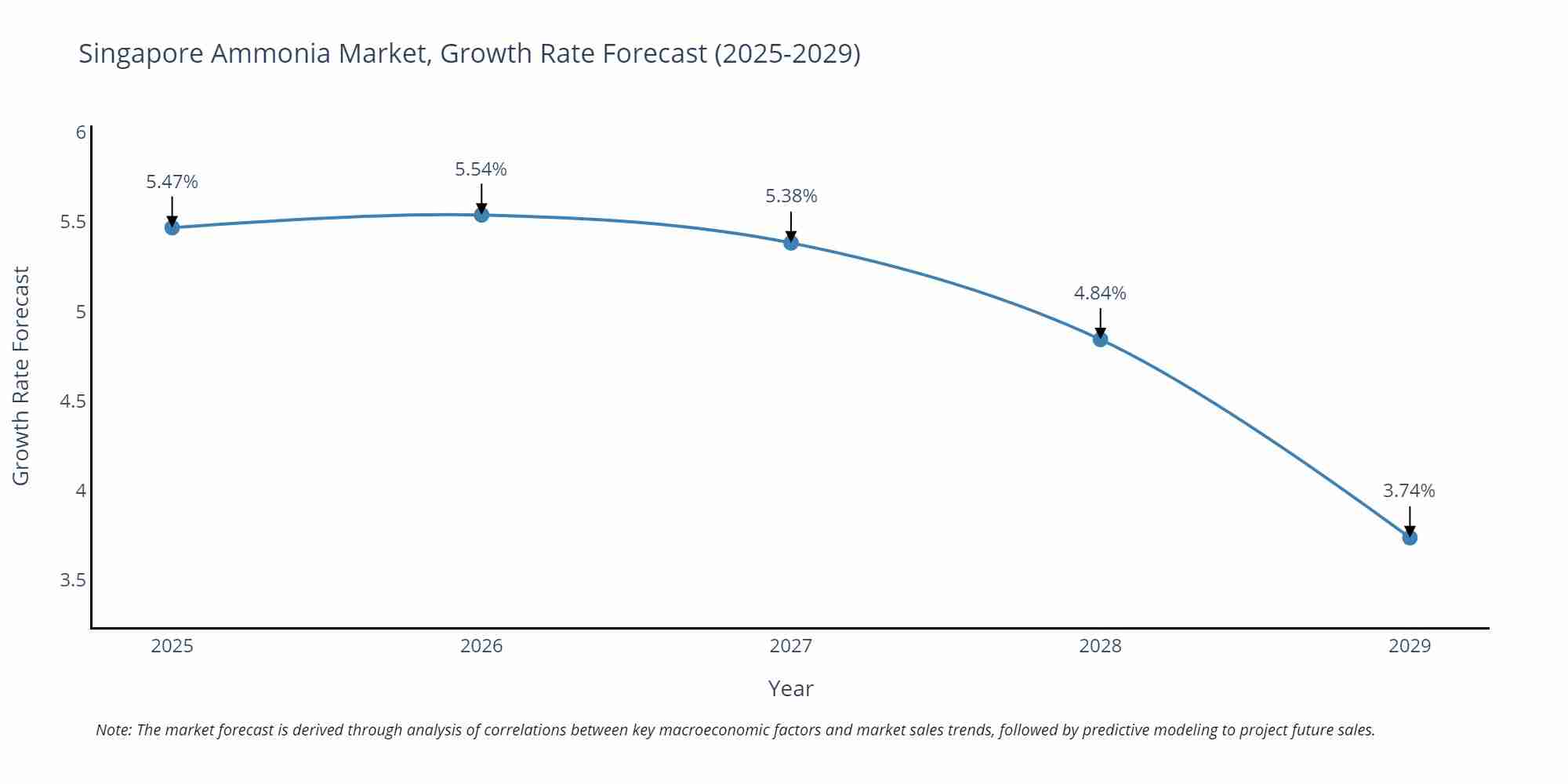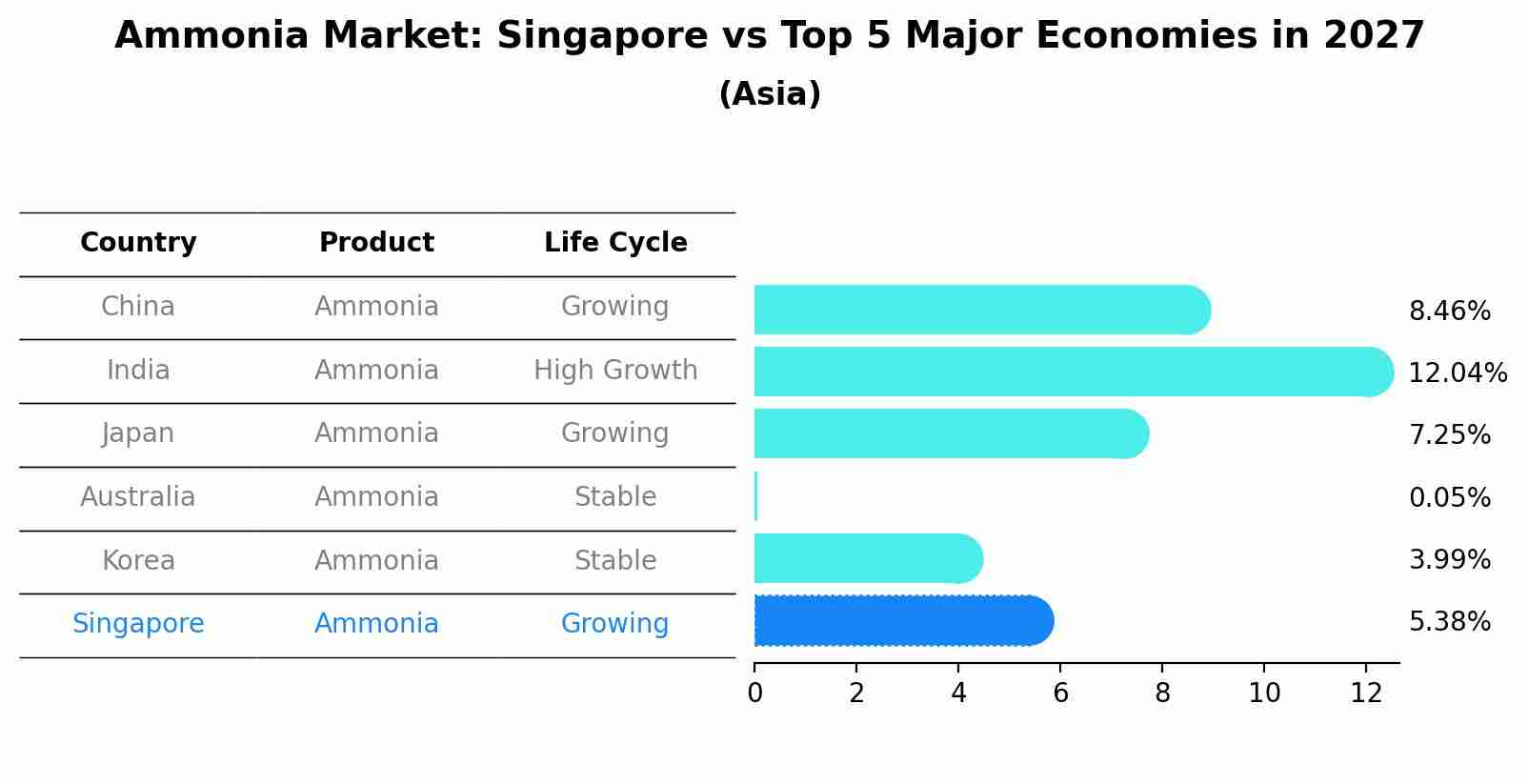Singapore Ammonia Market (2025-2031) Outlook | Trends, Value, Share, Revenue, Forecast, Size, Industry, Analysis, Companies & Growth
| Product Code: ETC194739 | Publication Date: May 2022 | Updated Date: Apr 2025 | Product Type: Market Research Report | |
| Publisher: 6Wresearch | No. of Pages: 60 | No. of Figures: 40 | No. of Tables: 7 | |
Singapore Ammonia Market Size Growth Rate
The Singapore Ammonia Market is projected to witness mixed growth rate patterns during 2025 to 2029. The growth rate begins at 5.47% in 2025, climbs to a high of 5.54% in 2026, and moderates to 3.74% by 2029.

Ammonia Market: Singapore vs Top 5 Major Economies in 2027 (Asia)
The Ammonia market in Singapore is projected to grow at a growing growth rate of 5.38% by 2027, highlighting the country's increasing focus on advanced technologies within the Asia region, where China holds the dominant position, followed closely by India, Japan, Australia and South Korea, shaping overall regional demand.

Singapore Ammonia Market Synopsis
Ammonia is a vital chemical compound used extensively in the manufacturing of fertilizers, chemicals, and refrigerants. In Singapore, the ammonia market is closely linked to the agricultural and chemical industries. The country`s commitment to sustainable agriculture and its strategic location as a trading hub for chemicals bolster the demand for ammonia. The market outlook remains promising as Singapore continues to invest in advanced agricultural practices and chemical production.
Drivers of the Market
The outlook for the Singapore ammonia market is positive, driven by various factors. One of the main drivers is the agriculture industry`s reliance on ammonia-based fertilizers. Singapore imports ammonia for agricultural use, and as global food demand rises, so does the need for efficient and effective fertilizers. Additionally, ammonia is a crucial component in the manufacturing of various chemicals, including explosives, refrigerants, and cleaning agents. The growing industrial and chemical sectors in Singapore and the broader Southeast Asian region are expected to fuel the demand for ammonia. Furthermore, ammonia is considered a clean energy carrier, and Singapore efforts to reduce carbon emissions may lead to increased use of ammonia as a hydrogen carrier in the future, further boosting its market prospects.
Challenges of the Market
The ammonia market in Singapore is confronted with various challenges that require attention. Firstly, the cost of raw materials and energy for ammonia production can be volatile, affecting the overall cost structure and competitiveness of ammonia manufacturers. Furthermore, environmental regulations and safety standards are stringent in the ammonia industry due to its potential hazards. Meeting these regulations while maintaining cost-effectiveness can be a substantial challenge. Lastly, market demand for ammonia may fluctuate, especially in the context of changing agricultural practices and the growth of alternative fertilizers, requiring businesses to adapt and diversify their offerings.
COVID-19 Impact on the Market
The Singapore ammonia market has faced significant challenges due to the COVID-19 pandemic. With the global disruption in supply chains and a decrease in industrial activity, demand for ammonia, a key ingredient in fertilizers and various industrial processes, has been adversely affected. The pandemic led to a slowdown in construction and manufacturing sectors, which in turn impacted the demand for ammonia-based products. Companies operating in this sector experienced reduced production and faced logistical challenges, disrupting the ammonia market`s stability.
Key Players in the Market
Ammonia has a broad range of applications, including in fertilizers and refrigeration. The market is expected to remain robust, with notable players like Yara International and OCI Nitrogen operating in the sector.
Key Highlights of the Report:
- Singapore Ammonia Market Outlook
- Market Size of Singapore Ammonia Market, 2024
- Forecast of Singapore Ammonia Market, 2031
- Historical Data and Forecast of Singapore Ammonia Revenues & Volume for the Period 2021-2031
- Singapore Ammonia Market Trend Evolution
- Singapore Ammonia Market Drivers and Challenges
- Singapore Ammonia Price Trends
- Singapore Ammonia Porter's Five Forces
- Singapore Ammonia Industry Life Cycle
- Historical Data and Forecast of Singapore Ammonia Market Revenues & Volume By Type for the Period 2021-2031
- Historical Data and Forecast of Singapore Ammonia Market Revenues & Volume By Liquid for the Period 2021-2031
- Historical Data and Forecast of Singapore Ammonia Market Revenues & Volume By Gas for the Period 2021-2031
- Historical Data and Forecast of Singapore Ammonia Market Revenues & Volume By End-user Industry for the Period 2021-2031
- Historical Data and Forecast of Singapore Ammonia Market Revenues & Volume By Agriculture for the Period 2021-2031
- Historical Data and Forecast of Singapore Ammonia Market Revenues & Volume By Textiles for the Period 2021-2031
- Historical Data and Forecast of Singapore Ammonia Market Revenues & Volume By Mining for the Period 2021-2031
- Historical Data and Forecast of Singapore Ammonia Market Revenues & Volume By Pharmaceutical for the Period 2021-2031
- Historical Data and Forecast of Singapore Ammonia Market Revenues & Volume By Refrigeration for the Period 2021-2031
- Historical Data and Forecast of Singapore Ammonia Market Revenues & Volume By Others for the Period 2021-2031
- Singapore Ammonia Import Export Trade Statistics
- Market Opportunity Assessment By Type
- Market Opportunity Assessment By End-user Industry
- Singapore Ammonia Top Companies Market Share
- Singapore Ammonia Competitive Benchmarking By Technical and Operational Parameters
- Singapore Ammonia Company Profiles
- Singapore Ammonia Key Strategic Recommendations
Frequently Asked Questions About the Market Study (FAQs):
1 Executive Summary |
2 Introduction |
2.1 Key Highlights of the Report |
2.2 Report Description |
2.3 Market Scope & Segmentation |
2.4 Research Methodology |
2.5 Assumptions |
3 Singapore Ammonia Market Overview |
3.1 Singapore Country Macro Economic Indicators |
3.2 Singapore Ammonia Market Revenues & Volume, 2021 & 2031F |
3.3 Singapore Ammonia Market - Industry Life Cycle |
3.4 Singapore Ammonia Market - Porter's Five Forces |
3.5 Singapore Ammonia Market Revenues & Volume Share, By Type, 2021 & 2031F |
3.6 Singapore Ammonia Market Revenues & Volume Share, By End-user Industry, 2021 & 2031F |
4 Singapore Ammonia Market Dynamics |
4.1 Impact Analysis |
4.2 Market Drivers |
4.3 Market Restraints |
5 Singapore Ammonia Market Trends |
6 Singapore Ammonia Market, By Types |
6.1 Singapore Ammonia Market, By Type |
6.1.1 Overview and Analysis |
6.1.2 Singapore Ammonia Market Revenues & Volume, By Type, 2021-2031F |
6.1.3 Singapore Ammonia Market Revenues & Volume, By Liquid, 2021-2031F |
6.1.4 Singapore Ammonia Market Revenues & Volume, By Gas, 2021-2031F |
6.2 Singapore Ammonia Market, By End-user Industry |
6.2.1 Overview and Analysis |
6.2.2 Singapore Ammonia Market Revenues & Volume, By Agriculture, 2021-2031F |
6.2.3 Singapore Ammonia Market Revenues & Volume, By Textiles, 2021-2031F |
6.2.4 Singapore Ammonia Market Revenues & Volume, By Mining, 2021-2031F |
6.2.5 Singapore Ammonia Market Revenues & Volume, By Pharmaceutical, 2021-2031F |
6.2.6 Singapore Ammonia Market Revenues & Volume, By Refrigeration, 2021-2031F |
6.2.7 Singapore Ammonia Market Revenues & Volume, By Others, 2021-2031F |
7 Singapore Ammonia Market Import-Export Trade Statistics |
7.1 Singapore Ammonia Market Export to Major Countries |
7.2 Singapore Ammonia Market Imports from Major Countries |
8 Singapore Ammonia Market Key Performance Indicators |
9 Singapore Ammonia Market - Opportunity Assessment |
9.1 Singapore Ammonia Market Opportunity Assessment, By Type, 2021 & 2031F |
9.2 Singapore Ammonia Market Opportunity Assessment, By End-user Industry, 2021 & 2031F |
10 Singapore Ammonia Market - Competitive Landscape |
10.1 Singapore Ammonia Market Revenue Share, By Companies, 2024 |
10.2 Singapore Ammonia Market Competitive Benchmarking, By Operating and Technical Parameters |
11 Company Profiles |
12 Recommendations |
13 Disclaimer |
- Single User License$ 1,995
- Department License$ 2,400
- Site License$ 3,120
- Global License$ 3,795
Search
Related Reports
- Portugal Occupational Health & Safety Services Market (2025-2031) | Strategy, Consumer Insights, Analysis, Investment Trends, Opportunities, Growth, Size, Share, Industry, Revenue, Segments, Value, Segmentation, Supply, Forecast, Restraints, Outlook, Competition, Drivers, Trends, Demand, Pricing Analysis, Competitive, Strategic Insights, Companies, Challenges
- Netherlands Occupational Health and Safety Services Market (2025-2031) | Strategy, Consumer Insights, Analysis, Investment Trends, Opportunities, Growth, Size, Share, Industry, Revenue, Segments, Value, Segmentation, Supply, Forecast, Restraints, Outlook, Competition, Drivers, Trends, Demand, Pricing Analysis, Competitive, Strategic Insights, Companies, Challenges
- Belgium and Luxembourg Facility Management Market (2025-2031) | Strategy, Consumer Insights, Analysis, Investment Trends, Opportunities, Growth, Size, Share, Industry, Revenue, Segments, Value, Segmentation, Supply, Forecast, Restraints, Outlook, Competition, Drivers, Trends, Demand, Pricing Analysis, Competitive, Strategic Insights, Companies, Challenges
- Russia Women Intimate Apparel Market (2025-2031) | Strategy, Consumer Insights, Analysis, Investment Trends, Opportunities, Growth, Size, Share, Industry, Revenue, Segments, Value, Segmentation, Supply, Forecast, Restraints, Outlook, Competition, Drivers, Trends, Demand, Pricing Analysis, Competitive, Strategic Insights, Companies, Challenges
- Africa Chocolate Market (2025-2031) | Size, Share, Trends, Growth, Revenue, Analysis, Forecast, industry & Outlook
- Global Hydroxychloroquine And Chloroquine Market (2025-2031) | Industry, Trends, Size, Outlook, Growth, Value, Companies, Revenue, Analysis, Share, Forecast
- Saudi Arabia Plant Maintenance Market (2025-2031) | Industry, Size, Growth, Revenue, Value, Companies, Forecast, Analysis, Share & Trends
- Taiwan Electric Truck Market (2025-2031) | Outlook, Industry, Revenue, Size, Forecast, Growth, Analysis, Share, Companies, Value & Trends
- South Korea Electric Bus Market (2025-2031) | Outlook, Industry, Companies, Analysis, Size, Revenue, Value, Forecast, Trends, Growth & Share
- Africa Low Temperature Powder Coating Market (2025-2031) | Companies, Competition, Size, Challenges, Segmentation, Trends, Competitive, Industry, Supply, Strategy, Investment Trends, Growth, Segments, Restraints, Strategic Insights, Revenue, Share, Forecast, Drivers, Analysis, Pricing Analysis, Demand, Consumer Insights, Value, Opportunities, Outlook
Industry Events and Analyst Meet
Our Clients
Whitepaper
- Middle East & Africa Commercial Security Market Click here to view more.
- Middle East & Africa Fire Safety Systems & Equipment Market Click here to view more.
- GCC Drone Market Click here to view more.
- Middle East Lighting Fixture Market Click here to view more.
- GCC Physical & Perimeter Security Market Click here to view more.
6WResearch In News
- Doha a strategic location for EV manufacturing hub: IPA Qatar
- Demand for luxury TVs surging in the GCC, says Samsung
- Empowering Growth: The Thriving Journey of Bangladesh’s Cable Industry
- Demand for luxury TVs surging in the GCC, says Samsung
- Video call with a traditional healer? Once unthinkable, it’s now common in South Africa
- Intelligent Buildings To Smooth GCC’s Path To Net Zero













